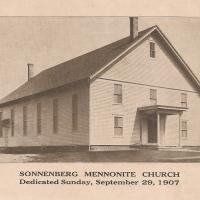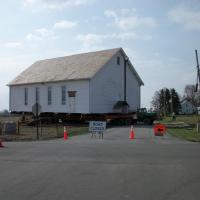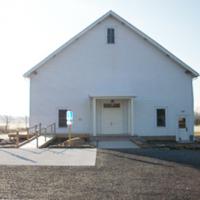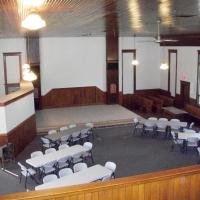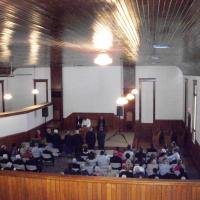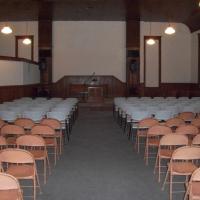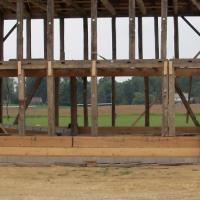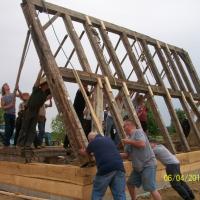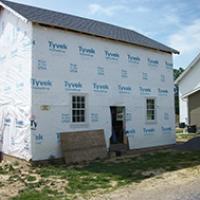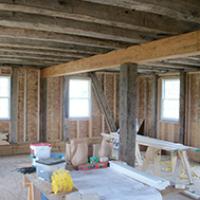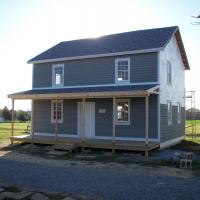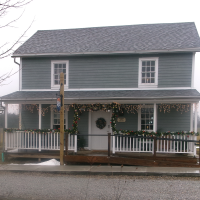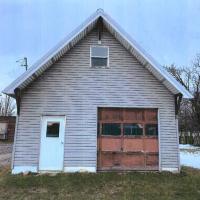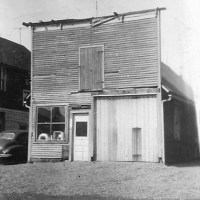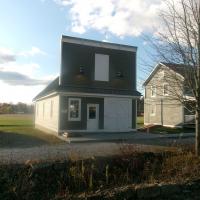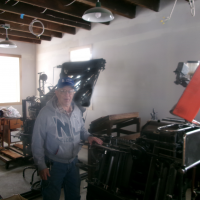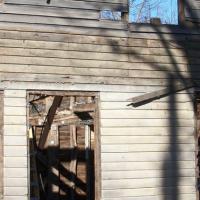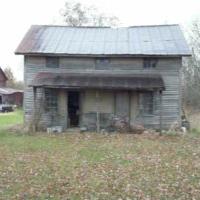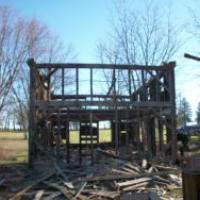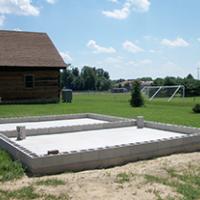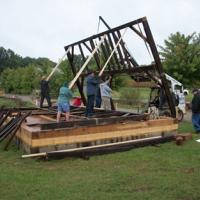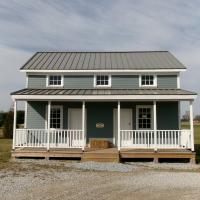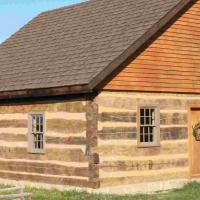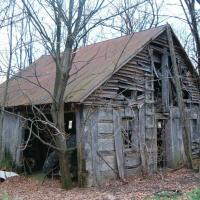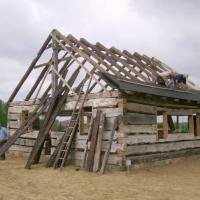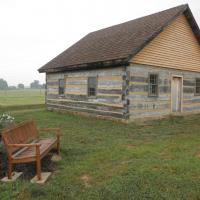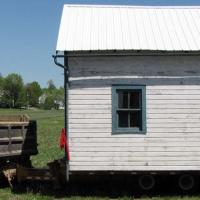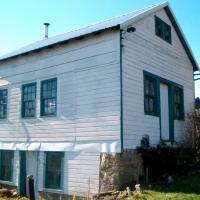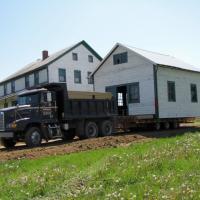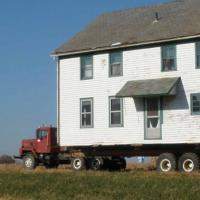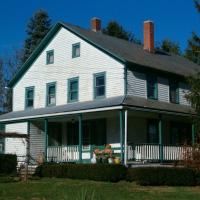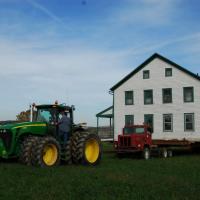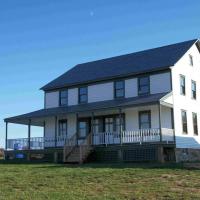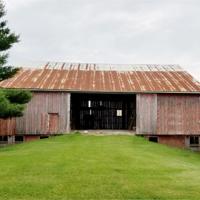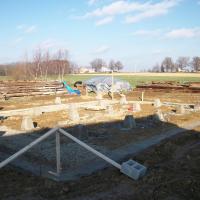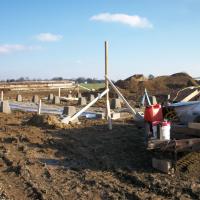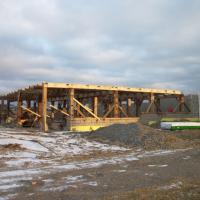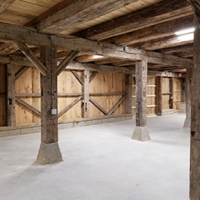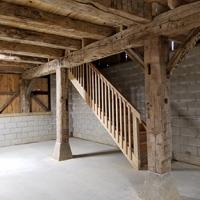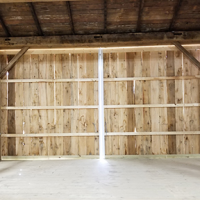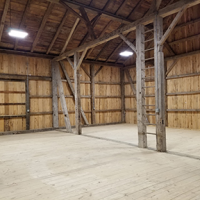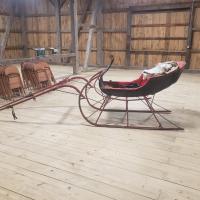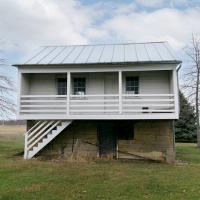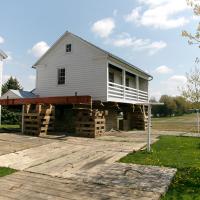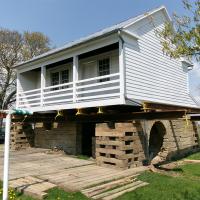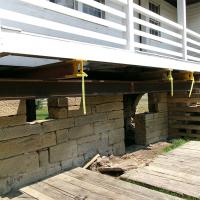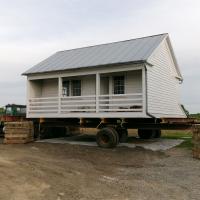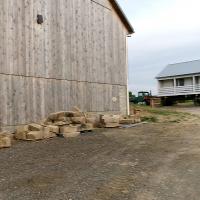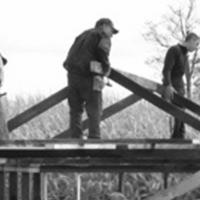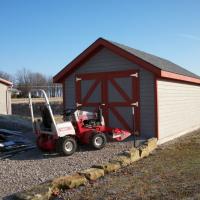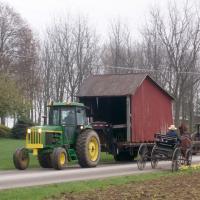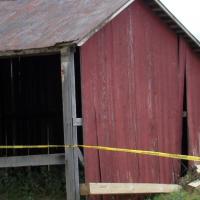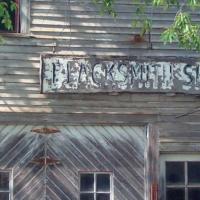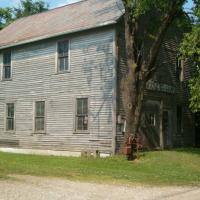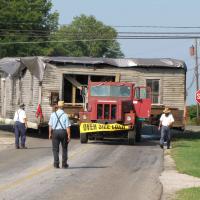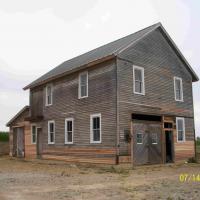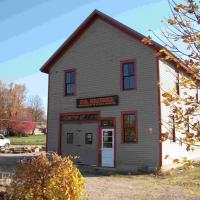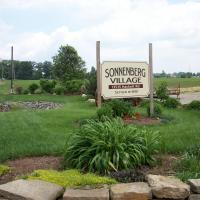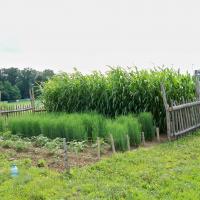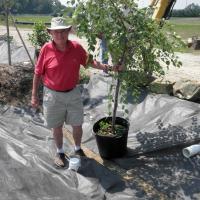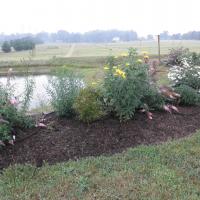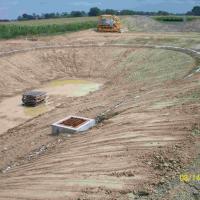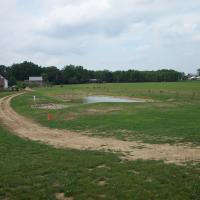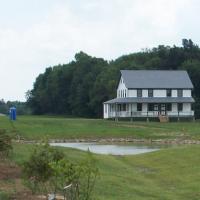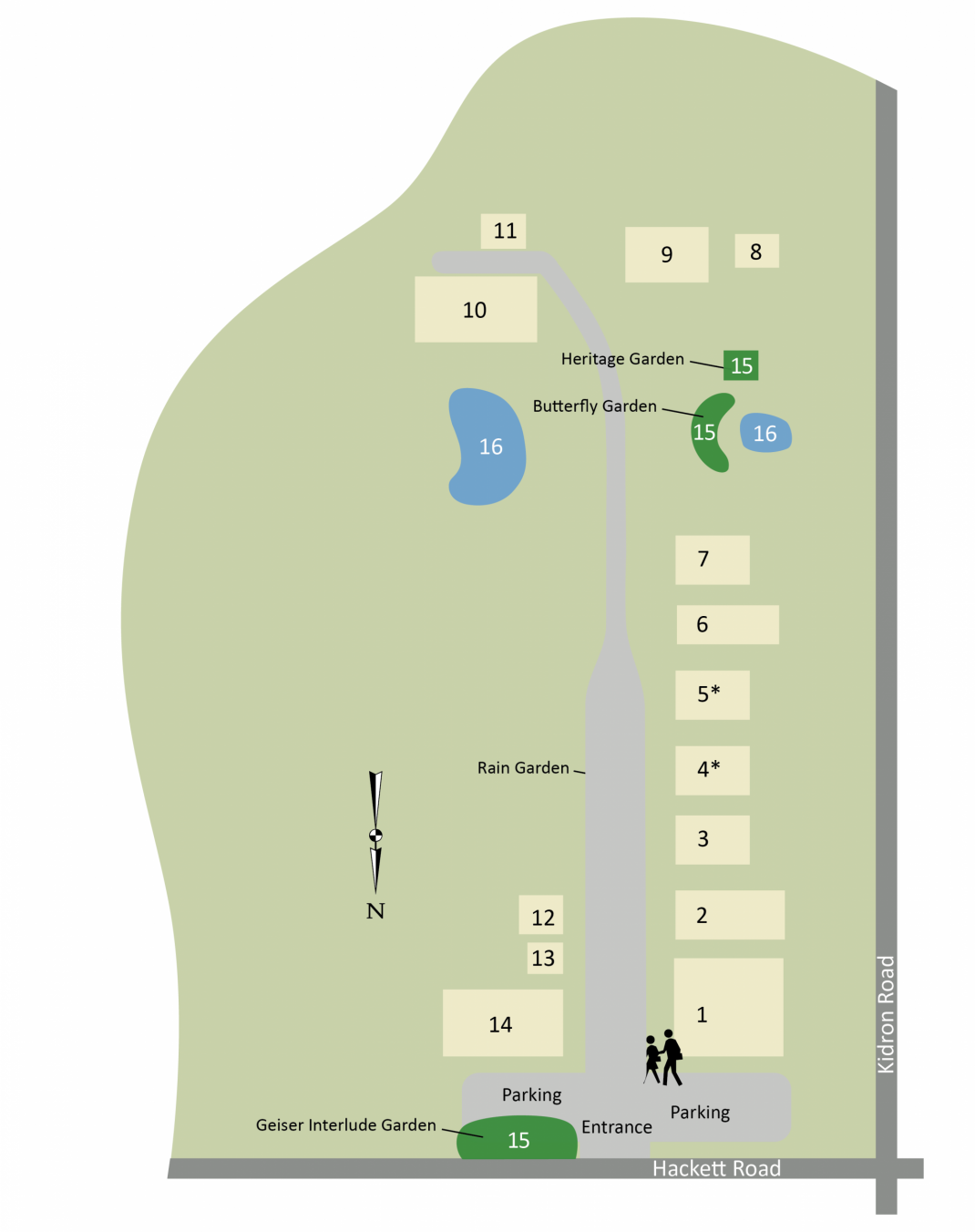
The Sonnenberg Village is a 5-acre campus located on the outskirts of Kidron, Ohio. It is located at located at 13497 Hackett Road, but has an Apple Creek mailing address. Here we maintain and preserve historical buildings and implement sustainable living methods that feature the use of green building technology and sustainable gardening and landscaping techniques. The campus currently has 12 permanent buildings in place with additional buildings waiting to be installed on their respective sites. Download a printable map here.
Hours
Regular operating hours have not yet been established at the Sonnenberg Village as it is still under construction. People are welcome to park and walk around the Village anytime if they wish. Any donations would be greatly appreciated as we work to complete the Sonnenberg Village!
Location
Physical address:
13497 Hackett Rd.
Apple Creek, OH 44606
Rentals
The Welcome Center is available to rent for weddings, reunions and events by calling (330) 857-9111.
Click on the corresponding map number below to view more information about Sonnenberg Village.
By July of 2007 the Kidron Community Historical Society had been offered eight buildings of importance to the history of the Sonnenberg area. Rather than attempting to maintain and preserve all the buildings on their original locations it was decided that the best course of action was to find a parcel of land big enough to place all the historic buildings together. The Leonard Geiser family graciously donated two acres of land with frontage on Hackett Rd. and permitted the society to purchase and additional three adjoining acres for this purpose and the Sonnenberg Village five-acre campus was born.
One of the original eight historic buildings acquired by the Society was the 1907 Sonnenberg Church that has been transformed into the Sonnenberg Village Welcome Center.
The old church began its journey to the Sonnenberg Village campus in April of 2013. It was a long haul, but thanks to Weaver Commercial Construction, Ivan Mast, and a little pull by Clarence Steiner, the Sonnenberg Church arrived safely at Sonnenberg Village on May 15, 2013.
Weaver Commercial Construction weatherproofed the building, reattached the front porch and completed the exterior siding work. A bathroom addition was tacked onto the building. The interior work included removing the old classrooms and is designed to include a display area in the aisle leading to the restrooms. After the basement ceiling was cleared for new wiring, and heating and air conditioning duct work, Kidron Electric installed the heating and air conditioning units in the attic and worked on the ducting. B. E. Hofstetter Trucking & Excavating leveled and completed the first two layers of the parking lot in front of the Welcome Center.
The Welcome Center dedication ceremony took place on February 25, 2014 and is now available to rent for weddings, reunions and events by calling (330) 857-9111.
The largest major summer project is the Bixler House. The College of Wooster has dated the building to 1832, so it is a significant addition to the village, dating back to early Swiss settlement of the area. Masons were hired to construct a full basement after Brian Hofstetter of B.E. Hofstetter Trucking and Excavating finished the excavation. At a frolic on May 4 with 30 helpers and 70 onlookers, the building went up in one day. Since then a roof has been placed on the house. Work has paused to evaluate the best way to proceed with exterior and interior finishes. The Bixler family and co-chairs Clair Bixler and Dr. Elton Lehman have organized this project.
Volunteers began the dismantling of the Garden House destined for Sonnenberg Village. The house was a gift from the Richard Shetler Family. Richard Shetler is the grandson of Enos Zuercher whose family has occupied the farm for four generations. The building was dismantled by the Leisy Family and friends and rebuilt in the Village during the spring and summer seasons of 2018. The Garden House supports the operation of the gardens and arboretum in Sonnenberg Village.
By July of 2007 the Kidron Community Historical Society had been offered eight buildings of importance to the history of the Sonnenberg area. Rather than attempting to maintain and preserve all the buildings on their original locations it was decided that the best course of action was to find a parcel of land big enough to place all the historic buildings together. The Leonard Geiser family graciously donated two acres of land with frontage on Hackett Rd. and permitted the society to purchase and additional three adjoining acres for this purpose and the Sonnenberg Village five-acre campus was born.
The Tschantz Log Cabin was one of the original eight historic buildings acquired by the Society and was the first building to be moved and rebuilt on the Sonnenberg Village campus. Leonard and Nada Geiser, owners of the farm where the log cabin stood, contacted the Kidron Community Historical Society and offered to donate the old log cabin to the Society provided it was moved. The 190-year-old cabin was in poor condition but most of the timbers used in its construction were salvageable.
John and Anna Tschantz, their son Abraham and his wife Anna, arrived in the Kidron Sonnenberg area in 1821 and by 1824 had built this log cabin. The College of Wooster was contracted by Tschantz family descendants to perform a wood age test and they confirmed that the log cabin was indeed built in 1824; making it one of the oldest surviving wood structures in Wayne County, Ohio.
Abraham and Anna Tschantz lived in this log cabin all their lives, raising 5 children there: John, Abraham, Elizabeth, Peter and Anna. Although the log cabin and farm was eventually sold to outsiders the Tschantz family log cabin remained on its original site until it was dismantled by descendants of the Tschantz family under the direction of Abe Troyer and moved to the Sonnenberg Village in 2008. Cousins, Vic Schantz and Dave Tschantz, direct descendants of Abraham Tschantz, and relative Peter Schantz, who has training in log construction agreed to restore the log cabin on the Sonnenberg Village campus.
By January of 2009 the foundation was completed for the cabin, and by July the Tschantz family had finished the roof and chinked the outside walls. During the Fall of 2009 the windows and doors were installed in the cabin. In the Spring of 2010 they completed the flooring and chinked the inside walls then spent the rest of the year putting the finishing touches on the cabin.
The Tschantz Log Cabin opened to the public for the first time during the 2011 Sonnenberg Homecoming. By the Summer of 2012 the cabin was completed with Sonnenberg pieces and furnishings of the time period.
By July of 2007 the Kidron Community Historical Society had been offered eight buildings of importance to the history of the Sonnenberg area. Rather than attempting to maintain and preserve all the buildings on their original locations it was decided that the best course of action was to find a parcel of land big enough to place all the historic buildings together. The Leonard Geiser family graciously donated two acres of land with frontage on Hackett Rd. and permitted the society to purchase and additional three adjoining acres for this purpose and the Sonnenberg Village five-acre campus was born. The board of directors hired Domenic Ferrante of Harris/Day Architects in Canton, Ohio to design the campus complex and secure “green” (environmentally friendly) certification. Ferrante worked with Alan Frasz, of Dovetail Solar and Wind, and Emmanuel Annunike, of the Ohio Department of Development, to design a wind and solar electric generating system for the village.
The Lehman Spring House was among the original eight donated buildings to populate the Sonnenberg Village campus. In May of 2010 the Lehman Spring house was raised-up on blocks and lifted off its original foundation in one piece. Then a flatbed trailer was rolled under it and it was lowered onto the trailer so it could easily make the journey to the Village where it was parked next to its longtime companion, the Lehman House, while it’s foundation was being built. Once the foundation was complete the Spring House was dropped into place on the new foundation.
The basement of the Lehman Spring House was completed by the end of 2010 and someday a water trough will be installed in the basement with a re-circulating pump so people can experience a simulation of a working spring house.
By the spring of 2011 landscaping around the Lehman Spring House was completed and a few finishing touches to the building are all that remain for it to be called completed.
By July of 2007 the Kidron Community Historical Society had been offered eight buildings of importance to the history of the Sonnenberg area. Rather than attempting to maintain and preserve all the buildings on their original locations it was decided that the best course of action was to find a parcel of land big enough to place all the historic buildings together. The Leonard Geiser family graciously donated two acres of land with frontage on Hackett Rd. and permitted the society to purchase and additional three adjoining acres for this purpose and the Sonnenberg Village five-acre campus was born.
One of the original eight buildings donated to the society was the Lehman House once located three miles northeast of Kidron on the south side of Goudy road between Zuercher and Wenger roads. The house was donated by Lloyd and Esther Lehman on the condition that it be moved from its original location.
The Lehman house was built circa 1838, most likely by Abraham Lehman (the great-great-grand uncle of the donor, Lloyd Lehman). The house is traditional for the time period and has experienced few changes over the course of its 176-year-old+ lifetime. Because the house was rather large and one of the few still remaining that featured four windows on all sides, it was a popular location for weddings. The wedding would take place upstairs, with the meal being served downstairs.
In 1976, the Wayne County Historical Society recognized the Lloyd Lehman House as a Pioneer House in Wayne County. According to the Wayne County Recorder’s Office, the succession of ownership for Sec. 21, Twp. 16, Range 11 (120 acres), is as follows: 1830– Christian Gileam to Abraham Lehman. 1847–Abraham Lehman to Isaac E. Lehman. 1881– Isaac E. Lehman to Christian Hofstetter. 1909–Christian Hofstetter to John C. Hofstetter. 1919–John C. Hofstetter 80 acres to Reuben R. Lehman. 1963–Reuben R. Lehman to Lloyd D. Lehman. In 2007-Lloyd and Esther Lehman to Kidron Community Historical Society.
The Lehman House was built with timber-frame construction with mud-filled walls on a sandstone foundation. It has two doors off the front porch as well as the commonly-used entry to the kitchen. Considered large, by Sonnenberg standards, the house features an enclosed center staircase, expansive rooms, and a full second floor, attic and basement.
The whole house in one piece was lifted off it’s original foundation and moved by Aden Mast of Mast Movers to the Sonnenberg Village campus on October 13, 2008. Aden Mast completed the new foundation on which the house now sits in Sonnenberg Village in the summer of 2009. In the fall of Fall 2011 a group of Amish volunteers planned a “roofing frolic” to replace the old leaking roof on the Lehman House. Staying true to the ideology of “going green” the shingles used on the Lehman House were made of recycled plastic material that has the appearance of wood shakes, and will carry a 50-year warranty. Under the leadership of Junior Miller and Dennis Troyer, nine roofers (Dennis Troyer, David Troyer, Paul Troyer, Junior Troyer, Junior Miller, Joe Miller, Paul Kauffman, Duane Mast, and Jered Staples) began working at 4:30 p.m. on Friday, August 19, 2011 to replace the roof with eco-slate and finished the job before the sun went down.
The fall of 2011 also saw Ray Leisy begin to work on the exterior of the house: replacing deteriorated wood siding, priming the wood, and painting. By the spring of 2012 the society had scheduled “work days” every Monday at 9AM to start restoring and remodeling the interior of the Lehman House. By the fall of 2012 new windows had been installed in the upstairs, the downstairs windows had been repaired and refinished, and two coats of paint had been applied to all the exterior surfaces of the house. Another group working on the inside of the house installed new electric wiring in the second floor and began rewiring the first floor. The hallway and three rooms upstairs had been plastered and new plumbing and a furnace installed.
The summer of 2013 saw the completion of work on the second floor. During the winter of 2014 the flooring was finished in the kitchen and bathrooms, the plumbing was connected and some minor painting completed, making the Lehman House nearly ready for occupancy.
The house was completed in the spring of 2015 and will be rented to caretakers for the Village. Two rooms in the downstairs will be reserved for displays of furniture to illustrate the early period of the house.
Archibald Steel and his son James Steel hired a timber framer to build a new barn in 1847. It is known in the trade as a “scribe rule barn”. In scribe rule framing, each connection between timbers is unique. The carpenter laying out joints in the frame used a pair of dividers and and a marking device to transfer the irregularities of one timber to its mate. This insured a tight joint, but required that the frame be assembled in exactly the way that it had been laid out. There are only two such barns known to still exist in Sugar Creek Township. It is a bank barn, many of which are disappearing from our landscape as they are no longer useful for modern farming.
The farm and barn passed through many families whose names are still well known in the Kidron area such as Baumgartner, Tschantz, Amstutz and eventually to Herman and Marilyn Gerber Nussbaum in 1956. The current owners, Glenn and Phyllis Nussbaum Gerber donated the building to The Kidron Community Historical Society to be disassembled and rebuilt in Sonnenberg Village.
Toting tools and using supplies provided by the village, five Central Christian School students and their faculty leader, Bob Troyer, spent October 17, 2014 volunteering at Sonnenberg Village.
One group worked with Dan Miller to install new siding and rafters on the storage shed while the second group assisted Cliff Lehman in building a wooden platform and steps to access the restrooms at the Welcome Center.
The storage building was donated by Will Gerber and once stood on the William S. and Mildred Nussbaum farm.
An original Sonnenberg Church buggy shed was brought into the village in early May. The shed was owned and used by Amos and Sarah Lehman to house their horse and buggy, and later their car, while worshiping at the third Sonnenberg Church building. Ray and Joan Nussbaum inherited the shed when they bought the Amos Lehman property and by 1998 had donated it to the KCHS. Jay Lehman, Amos’s nephew, agreed to store it at his place, once owned by his father Ezra. After standing on a cement barnyard for 18 years, it was moved to the village by Phil Neuenschwander, two of his sons and D.E. Nussbaum and is now awaiting a foundation and restoration.
The Floyd R. Saurer Blacksmith Shop was acquired through the Bill Sommer family and was among the original eight historic buildings donated to the KCHS. The old blacksmith shop was built in 1906 on Emerson Rd. east of the square in Kidron by Jacob P. Sommer, who hired George Houmard to work as the first blacksmith in the building. John F. Moser bought the building in 1912 and added a buggy shop. John F. Moser eventually hired Floyd R. Saurer to work as an apprentice and Saurer soon after bought the business and building from Moser. Floyd Saurer continued to own and operate the blacksmith shop until closing it’s doors in 1967.
The shop was left undisturbed exactly as Floyd Saurer left it when he closed the doors. In the fall of 2008 members of the KCHS entered the building and photographed all the tools exactly as Floyd had left them. Volunteers, Fred Hershberger, who oversaw the dismantling of the Saurer Blacksmith Shop, and Curt Nussbaum, Eldon Kornhaus, Bob Gerber, Vilas Bixler, Wayne H. Miller, spent almost two years tagging, cleaning, and cataloging all the items in the shop for storage until the blacksmith shop could be moved. The projected cost of dismantling, moving and restoring the blacksmith shop was $50,000.
The summer of 2011 saw the big old tree in front of the Saurer Blacksmith Shop get taken down and final permits secured in preparation for moving the old building to Sonnenberg Village. A new foundation was built for the blacksmith shop on the Village campus. In the fall of 2011, the second floor and roof trusses were removed from the blacksmith shop to make it easier to move. The remaining piece of the building was lifted from it’s original foundation in one piece and loaded onto a flatbed trailer. On September 13, 2011, with the help of the Kidron Volunteer Fire Department controlling traffic along the route, the building was hauled westward to the square and north on Kidron Rd. under the watchful eyes of many who lined the road to see the great move. After careful maneuvering at the Kidron & Hackett Rd. intersection, it was only a short trip to its new home in the Sonnenberg Village.
By the summer of 2012 new windows were installed in the shop and the exterior renovation was completed. Then work began to reinstall all the tools and equipment in the Blacksmith Shop just as it was when Floyd Saurer closed the doors in 1967. Fall of 2012 saw the equipment in the shop being repaired to operational status and a chimney installed. In 2013 the finishing touches were applied to the Floyd R. Saurer Blacksmith Shop with the electrical wiring being completed in the shop and installation of a natural gas line to the building. Outside, three Dunstan Chestnut trees were planted near the Shop and the Tschantz Cabin to complete the landscaping.
The Floyd R. Saurer Blacksmith Shop was open to the public for the 2013 Sonnenberg Homecoming.
The Mennonite philosophy of “harmony with nature” is reflected in the Sonnenberg Village by the construction of four major gardens:
Geiser Interlude Garden
This is the flower garden surrounding the Sonnenberg Village entrance sign on Hackett Rd. It was established to honor Leonard and Nada Geiser who donated the original two acres of land to establish the Sonnenberg Village.
Heritage Garden
This garden was established to demonstrate the use of heirloom vegetable plants without the use of chemicals.
Rain Garden
The rain garden located in the center of the Village was designed by Rebecca Little and the Ohio Agricultural Research and Development Center (OARDC) and installed by the staff of the Ohio State University’s Secrest Arboretum to filter and absorb rain water before runoff. Plant lists for the Rain Garden are available at the Sonnenberg Village Welcome Center.
Butterfly Garden
Certified by the Monarch Watch as a Monarch way station. It contains plants to nurture and promote butterflies. It was installed with the help of biology students from Central Christian High School. Plant lists for the Butterfly Garden are available at the Sonnenberg Village Welcome Center.
By July of 2007 the Kidron Community Historical Society had been offered eight buildings of importance to the history of the Sonnenberg area. Rather than attempting to maintain and preserve all the buildings on their original locations it was decided that the best course of action was to find a parcel of land big enough to place all the historic buildings together. The Leonard Geiser family graciously donated two acres of land with frontage on Hackett Rd. and permitted the society to purchase and additional three adjoining acres for this purpose and the Sonnenberg Village five-acre campus was born. During the summer of 2008 The board of directors hired Domenic Ferrante of Harris/Day Architects in Canton to design the Sonnenberg Village campus and secure “green” (environmentally friendly) certification. Ferrante worked with Alan Frasz, of Dovetail Solar and Wind, and Emmanuel Annunike, of the Ohio Department of Development, to design a wind and solar electric generating system for the village.
In 2008 biology students at Central Christian High School consulted with the Ohio Division of Soil and Water to propose a pond and wetlands on the Sonnenberg Village campus that would link to a wetlands on the school grounds of Central Christian High School. They completed a study and design for the pond, then submitted a grant application for funding from the Ohio Clean Water Fund.
By the summer of 2009 the Village needed a way to satisfy the federal Environmental Protection Agency (EPA) requirements regarding drainage and water control. The main flood and water control work was done by B. E. Hofstetter Trucking and Excavating to the satisfaction of the EPA. Volunteers helped build a water retention spillway from Hackett Rd. to the Tschantz Cabin, and helped to re-contour the parking area, and installed an 18-inch storm sewer through the Village to also help meet some basic EPA requirements.
In the spring of 2012 a $50,000 grant from the Muskingum Watershed Conservancy District was awarded to the Sonnenberg Village project thanks to the efforts of the Central Christian High School biology students. The fund helped to create a demonstration project for controlling and cleaning runoff water. The watershed district awarded the grant based on the work already completed on the Rain Garden and water retention spillway. The grant provided funds to finish the work on the east side of the Village and install a pond to satisfy all the EPA’s requirements.
The summer of 2013 saw a few shade trees planted around the pond, completing the projected landscaping for the grounds.
Map is not to scale.
*Proposed site.

